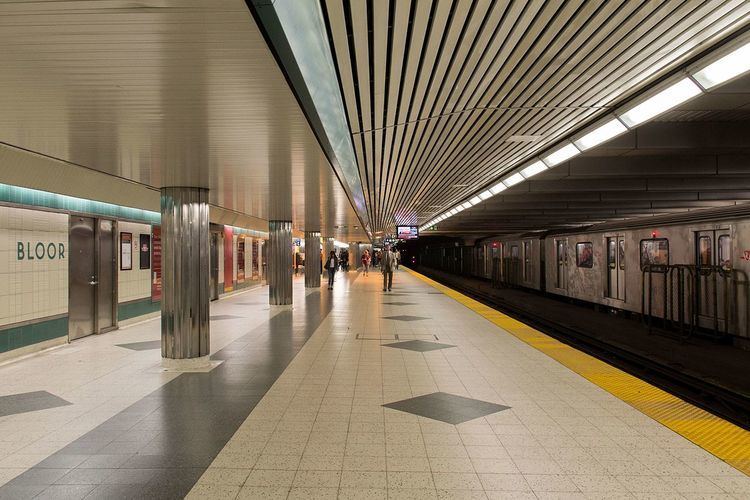Structure type underground Disabled access Yes Level 2 Tracks 4 | Platform levels 2 Province Ontario Platforms in use 2 Architect Charles B. Dolphin | |
 | ||
Location 20 Bloor Street East,
Toronto, Ontario
Canada Owned by Toronto Transit Commission Connections TTC buses
97 Yonge
300 Bloor-Danforth
320 Yonge Address Toronto, ON M4W 1A8, Canada Owner Toronto Transit Commission Similar Yorkville - Toronto, St George, Spadina, Bay, Finch | ||
Bloor-Yonge is a subway station on Line 1 Yonge–University and Line 2 Bloor–Danforth in Toronto, Ontario, Canada. It is located downtown, under the intersection of Yonge Street and Bloor Street. It is the busiest subway station in Toronto; more than 400,000 rides are taken on an average weekday. Wi-Fi is available at this station.
Contents
History
The station was opened in 1954 and designed by Charles B. Dolphin. It was originally named "Bloor", and connected with a pair of enclosed platforms in the centre of Bloor Street to allow interchange with Bloor streetcars within the fare-paid zone. When the streetcars were replaced with the Bloor-Danforth subway in 1966, the station began to be shown on maps as "Bloor–Yonge". However, actual platform signs still show "Bloor" on the Yonge-University line and "Yonge" on the Bloor–Danforth line, following a naming style common in New York subway station complexes, where only the platform's cross street is shown on the platform signs. (Some maps over the years also showed the station with two names "Bloor" and "Yonge", although the style "Bloor–Yonge" is now in use again; both are retronyms of Bloor Station.)
Similarly, the automated station announcement system installed in 2007–8 refers to the station as "Bloor" on Line 1 and "Yonge" on Line 2 respectively. The new Toronto Rocket subway trains that operate on Line 1 use a new computer-generated stop announcement system that refers to the station as "Bloor–Yonge". It is the only TTC station named in this way; all other interchanges share the same name for both lines, including Sheppard–Yonge.
The station used to feature a small retail concourse along the corridor leading from the entrance at the south side of Bloor Street. This concourse was closed and disappeared during the construction of the office building at 33 Bloor Street East in the late 1980s.
Due to its congestion, the TTC has had to expand the station. In 1992, it took advantage of building construction over the Yonge–University portion of the station to open it out and widen the platforms. This was the first stage of a plan, known as the Spanish solution, to enable trains to open their doors on both sides: the tracks would next have been slewed outwards within the widened station, and a central platform built between them. The TTC does not intend to proceed with that plan.
In 1996, the station became accessible with elevators as one of the TTC's first accessible stations.
The TTC experimented with crowd-control measures on the southbound platform of the Yonge–University level on November 24, 2009, and made these permanent as they allowed for improved passenger flow by discouraging crowding near the stairs leading to the Bloor–Danforth level. These measures also reduced dwell times by a few seconds, such that a few more trains can enter the station during rush hour without building additional capacity.
Increasing ridership has led to overcrowding of the station and discussion of a potential Downtown Relief Line. The TTC took various crowd-control measures during peak periods; empty trains were often dispatched to the station to clear the platform. Signal upgrades and other improvements on Line 1 have relieved the station and line of some crowding, but a study conducted by Metrolinx concluded that the benefits would only last until 2031.
As of March 2014, a trial for new numerical signage referring to the subway routes such as Line 1 for the Yonge line and Line 2 for the Bloor line were phased in on signs and maps at the station.
Subway infrastructure in the vicinity
North of the station the Yonge–University line crosses under Church Street in a tunnel then emerges to the surface at the Ellis Portal, continuing in an open cut through Rosedale Station. South to Wellesley Station, the line was constructed by cut and cover, with the surface areas now occupied by a Toronto Parking Authority multi-storey garage at Charles Street and three parks maintained by the City of Toronto – George Hislop Park, Norman Jewison Park, and James Canning Gardens south of that.
The east–west Bloor–Danforth centre platform was constructed under the existing north–south Yonge–University side platforms, and at that time they were connected by stairs; escalators and have subsequently been made fully accessible by elevator.
Between Yonge and Sherbourne Station to the east, the Bloor–Danforth line crosses to the south side of Bloor Street in a 2,250 feet (690 m) long section of bored tunnel, rather than the shallow cut-and-cover method used to construct most of the line. Cumberland Terrace, a two-storey shopping centre, has been built over the right of way west of Yonge Street to Bay Street.
Nearby landmarks
Nearby landmarks include the Toronto Reference Library, the Hudson's Bay Company's The Bay Uptown department store located in the Hudson Bay Centre at 2 Bloor Street East, and 2 Bloor Street West.
Surface connections
A paper transfer is required to connect to surface routes:
